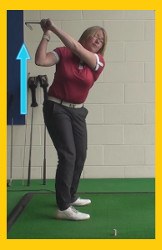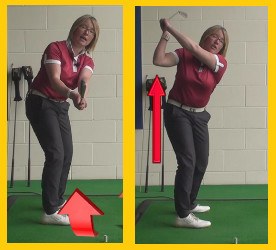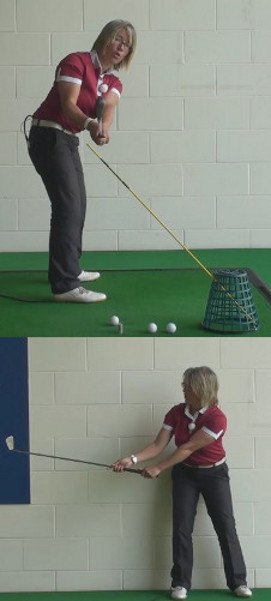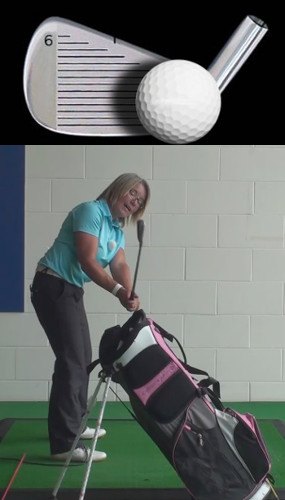
A laid off golf swing describes a position at the top of the swing where the club points to the left of the intended target line for the right-handed golfer. It should be noted that this assumes the swing is a full swing i.e. club shaft horizontal to the ground.
Having the club laid off at the top of the backswing often results from a fault lower down in the back swing or takeaway motion.
A golfer, who has a tendency to take the club outside the correct line in the backswing or moves the hands away from the body in the early stages of the backswing, would normally lay the golf club off too much in the second half of the backswing motion. This results in the club pointing left of the intended target line at the top. The resulting downswing can then be too flat and from the inside, causing blocks, hooks and possibly even shanks.

In order to correct the laid off at the top of the backswing position, the most useful training aid for a golfer is to use a full length mirror, placed directly behind them on the ball to target line. From a good stable address position, rotate your shoulders and avoid using any excessive wrist or forearm action. Take the club back to hip level so that the shaft of the golf club points directly down your target line. Now look into the mirror and notice how the club head should sit directly on top of your hands.
You should not be able to see any of the shaft when viewed in the mirror at this height. This would show an on plane backswing. If the club head is too far in front of the hands, this would be classed as outside of the line and is a key reason why the club could then appear to be laid off at the top of the swing.
Start your swing on the right track to keep it on the right track.

Cause and Cure of a Laid Off at the Top Golf Swing
The top of the backswing is a great reference point to check on the quality of your mechanics. Either by freezing at the top of your swing or by taking a video and pausing the replay at the top, you can learn a lot about the strengths and weaknesses of your technique. Specifically, you can check on the position of the club itself to determine if you have remained 'on plane' from address on up to the top. When the club is pointing directly at the target at the top of your swing, you are said to be on plane – and you are in great position for the downswing. However, if the club is pointing to the left or right of the target, there may be an issue in the swing which needs to be corrected.
In this article, we are going to deal with the problem of being laid off at the top of the swing. What does it mean to be in a laid off position? Basically, for a right-handed golfer, the swing is laid off when the club points to the left of the target at the top. If you were to record your swing on video and pause the recording when you reach the top of your backswing, seeing the club pointed out to the left would indicate that you are laid off. On the contrary, a swing where the club is pointing to the right of the target at the top is said to be across the line. While each of these mistakes can lead to plenty of trouble, this article will be dedicated to solving the laid off issue.
Unfortunately, it is not always easy to get to the bottom of this matter, as there are a few different potential causes for arriving in a laid off position. Also, this mistake does have the potential to create serious problems in your game, so solving it as soon as possible is going to be necessary. It can be hard to even enjoy your time on the course when swinging from a laid off position, specifically because you will be prone to producing shanks. No one wants to play golf with the fear of a shank in the back of their mind, so take care of this issue right away and move on to other swing improvement projects.
Before you decide to work on improving the position you reach at the top of your swing, it is important to confirm that you are actually laid off to begin with. You don't want to get into this process and start making changes to address problems you don't even have in your game. The corrections you need to make to get back on track from a laid off swing are very specific, and they aren't relevant for players who already have the club in a good position. Use video or the help of a friend to confirm your current swing is laid off before you decide to work on this point.
All of the content below is based on a right-handed golfer. If you happen to play left-handed, please take a moment to reverse the directions as necessary.

Signs of a Problem
Before you go looking for ways to correct your laid off swing, you will have to realize that you are laid off in the first place. As is the case with anything else in golf, the best way to learn about your game is to watch your ball flight. When you see what is happening with the ball as it flies, you can then use that information to diagnose problems which may exist in your technique. In the case of a laid off golf swing, there are a few potential warning signs which may pop up in your game. Review the list below and see if any of these ball flight problems sound familiar.
- The shanks. This is never a fun topic for any golfer to address, but it is possible that a laid off position at the top of the swing could lead you into a case of the shanks. With the club laid off, you will basically be opening up the hosel to the golf ball as you swing down. It is possible to avoid a shank if your hands are quick enough to square up the face before impact arrives, but you will always be relying on excellent timing to avoid a nasty shank. If you can move the club into a better position at the top, the hosel will be farther away from the ball at impact and you can play your golf without living in fear of a shank popping up out of nowhere.
- Frequent hooks. If you are consistently hooking the ball from right to left with a variety of clubs in your bag, there is a good chance you are laid off at the top. A laid off swing is usually going to bring the club into impact from a significantly inside-out path – meaning a hook will always be possible. When you combine that inside-out path with active hands through the hitting area, the club will close down and you will impart hook spin. While the occasional hook is not serious cause for concern, falling into a pattern of hooked shots should tip you off to the fact that something is wrong with your technique. Check for a laid off position at the top when you are fighting a hook, as this is one of the leading causes of the right to left pattern.
- Pushed shots to the right. There is a fine line between hitting a hook and hitting a pushed shot to the right of the target. Both of these shots start with a swing which comes dramatically from inside-out through the hitting area. When you hit a hook, your hands are active and the face closes down at the moment of impact. On the other hand, with a push, your hands are less active and the face hangs open through the ball. Since these two mistakes are so closely related, both of them can be caused by a laid off swing. In fact, golfers who have the club in a laid off position at the top will commonly go back and forth between pushed shots and hooks. If your game is stuck in a pattern of hitting a collection of hooks and pushes throughout the day, it is almost certain that you have the club laid off at the top.
If any of the three issues listed above regularly shows up in your swing, you should quickly check to see if you are laid off at the top of your backswing. You don't want to let these problems carry on any longer than necessary, as it will only get harder and harder to fix your technique as time goes by.

The Causes of a Laid Off Position
As was mentioned earlier, you can wind up in a laid off position for a number of reasons. Before you can make any progress on improving in this area of your swing, you first need to know why you are winding up with the club pointed to the left of the target. Obviously, you are making some sort of technical error, but what is that error, exactly? Get to the bottom of this question and you will be a big step closer to getting back on track.
The list below contains some of the potential causes of a laid off golf swing. Compare these mistakes to your own swing to see if you can determine which one is to blame.
- Active hands in the takeaway. Without question, this is the leading cause of a laid off golf swing. During the takeaway, your hands should be 'quiet' as the shoulders do the work of turning the club away from the target. When executed properly, the club stays beautifully on plane and it usually arrives at the top in a nice position. Unfortunately, many amateur golfers decide to use their hands actively in the takeaway as well. When that happens, the club is usually forced to the inside, and it winds up being laid off at the top. Check your swing for signs of active hands within the first foot or so of the backswing – if you see that your hands and wrists are influencing the path of the club at this point, you will know there is a problem to correct.
- Flat setup position. A laid off position at the top of your swing is a common trait in a flat golf swing, so it stands to reason that your swing would be laid off if you set up with the club flat at address. Often, golfers who hunch over rather than using good posture will be guilty of setting up with the club flat to the ground. One way you can tell if you are making this mistake is to check the positioning of the sole of the club at address, as compared to the ground. Is the club soled nicely on the ground, or is the heel on the turf while the toe is in the air? If you see that the toe of the club is up in the air, it is likely that you have the handle too low – and the club will be in a flat position overall. When you start out with the club in a flat address position, you will need to make a correction to avoid winding up in the laid off position that we are trying to avoid. Do your best to sole the club nicely at address and you should stand a much better chance to swing back on a good plane.
- Poor shoulder turn. It will be difficult to get the club into position using your arms alone. If you fail to make a quality shoulder turn going back, your backswing as a whole will be short and the club may be laid off. The correction here is obvious – work on improving your shoulder turn to make sure your back is facing the target at the top of the swing. Focus on turning your left shoulder under your chin to get back behind the ball properly. Even if you aren't highly flexible, you should still be able to get into a good position by using proper technique. A bigger shoulder turn means you don't need to use your arms as actively in order to place the club on plane at the top.
- Coming up out of your posture. This is a potential cause of a laid off position despite the fact that few amateur golfers would ever think to look in this direction. At address, you should be set up in a solid stance with your knees flexed, back straight, and chin up. As the swing progresses, it is important that you maintain that same stance you built to begin with. If you come up out of your stance at the top of the backswing, you will not only make it more difficult to hit the ball solidly – you will make it more difficult to keep the club on plane as well. Coming out of your stance will flatten out your shoulders and the club is likely to be laid off as a result. Be sure to maintain both your knee flex and the tilt in your hips in order to stay over the ball nicely.
Each of the mistakes listed above has the potential to throw your swing off track. Sure, you might be able to get away with making these mistakes from time to time by adjusting other parts of your technique, but you will be playing with fire. In the long run, it is unlikely you will be able to produce quality golf when one or more of these issues is present in your game.

Getting Back on Track
So, by this point, you should have determined if you are, in fact, dealing with a laid off swing – and if so, you should have figured out what it is that is causing the error. The next step, as is always the case in golf, is to head out to the driving range to make the necessary corrections. This is going to be the hard part, but it is also an exciting opportunity. If you are able to adjust your swing as necessary to correct the positioning of the club at the top, you can quickly straighten out your ball flight. There is a very real chance that fixing your mistake on this point will shave several strokes per round off of your score.
The exact points you need to work on at the range will depend on the underlying cause that you have pinpointed as the cause of your struggles. Use the tips provided earlier in this article to track down your error and then set to work on taking it out of your swing once and for all. No matter what kind of mistake you are trying to iron out, there are a few tips you can use to set yourself up for success. Those tips are listed below.
- Start with small clubs. It might be tempting to immediately reach for your driver to see how well you are doing with your new and improved swing, but doing so would only set you up for frustration. Instead, start with your short clubs and stick with them until you are confident the swing change has taken effect. Even if you have to hit short irons only for the first few practice sessions, your patience will be rewarded in the long run. There will be plenty of time later to hit your driver off into the distance – for now, stick with your short clubs and pay careful attention to your technique.
- Be nice to yourself. This is something that many golfers struggle with, whether on the range or on the course. Golfers are notoriously hard on themselves, getting frustrated and even angry over small mistakes. If you are going to make any meaningful progress in your game, it is important that you take a 'big picture' approach to each practice session. Be nice to yourself when you make mistakes, be patient with your progress, and look for little signs of improvement along the way.
- Stay away from the course. After a range session or two, it will be tempting to book a tee time in order to test out your new skills on the course. Resist this temptation, however, and stick to the range for at least a few more sessions. When you head to the course, it will be easy to fall back into old habits – which is exactly what you need to avoid at this time. It takes quite a few repetitions to become comfortable and confident in your new technique. Give yourself the time needed and hold off on playing another round of golf until you have had enough practice time. When you do return to the course, consider playing your first round solo in order to keep the focus on your technique and not on competition with another golfer.
The tips above should be helpful when making any kind of improvement to your swing, whether related to a laid off position or not. Once you learn the right process for incorporating new techniques into your game, you can repeat that process time after time as you continue to make improvements.

Recovering from the Shanks
If the laid off position you were finding in your golf swing caused you to hit a few shanks, you might have some residual confidence issues on the course – even if you have improved your technique. The shanks, much like the yips on the greens, are difficult to erase from your memory. Golfers who have only hit one or two shanks in their entire career on the course will still have trouble from time to time eliminating that pesky thought.
So how can you 'clean the slate' mentally once you have fixed your swing? The first thing you need to do is hit plenty of balls on the practice range. By hitting shot after shot on the range, with no shanks in sight, you will slowly but surely move farther and farther away from that shank problem. Think about it this way - you want to put as many quality shots between you and your last shank as possible. Make regular visits to the range and rack up a nice quantity of quality swings. The experience of hitting so many good practice shots will do wonders for your confidence.
Another helpful tip for clearing the shanks from your mind is to focus intently on your pre-shot routine when on the course. Create a specific pre-shot routine for use before every single shot you play – and then stick to that routine from the first hole on through to the last. When your mind is preoccupied with completing your routine correctly, you won't be able to spend time thinking about the shanks. This technique can help you work through any kind of crisis of confidence you may face. Build up your pre-shot routine and count on it to get you through even the most difficult rounds.
It is difficult to play good golf when you are swinging from a laid off position. Some golfers will see their laid off backswing result in shanks, while others will simply wind up with pushes and hooks. Either way, you need to get your backswing plane on track if you are going to improve your level of play going forward. Use the information contained in this article to move in the right direction and put in the practice time necessary to adjust to your new technique. With an on-plane swing now working in your favor, better golf – and lower scores – should be right around the corner. Good luck!






